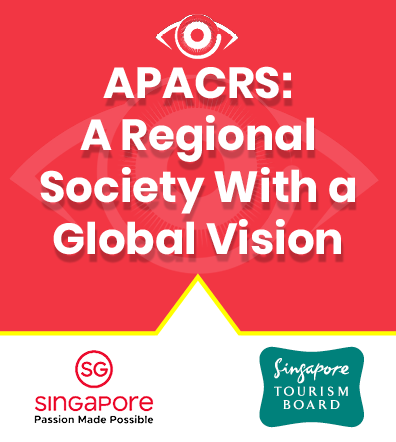Eyeworld Weekly Update |
Volume 20, Number 15 |
10 April 2015 |
- FDA grants Priority Review to lifitegrast NDA for dry eye treatment
- Single test can predict myopia
- Eyeliner can cause vision problems
FDA grants Priority Review to lifitegrast NDA for dry eye treatment
The Food and Drug Administration has "accepted for filing" the New Drug Application (NDA) for lifitegrast (Shire, Lexington, Mass.), as well as granting a Priority Review designation for accelerated review, Shire officials said in a press release.
The FDA is expected to provide a decision on Oct. 25, 2015, based on the Prescription Drug User Fee Act V action date, the release said.
"The symptoms of dry eye are one of the most common complaints from patients, yet there remains a tremendous unmet need," Stephen C. Pflugfelder, MD, professor of ophthalmology at Baylor College of Medicine, Houston, said in the release. "It's encouraging to see Shire moving the program for lifitegrast forward." According to the release from Shire, lifitegrast is an investigational treatment for dry eye disease in adults and "if approved, has the potential to be the first treatment indicated to address both signs and symptoms of the disease." The filing follows 4 clinical trials with more than 1,800 patients, with a phase 2 study, 2 phase 3 efficacy and safety studies, and 1 long-term phase 3 safety study.
Single test can predict myopia
A long-term study in more than 4,500 U.S. children has identified a single test that can predict which kids will become nearsighted by the eighth grade: their current refractive error. The Ohio State University researchers also dispelled the notion that near work can cause myopia, the university said in a news release.
The Collaborative Longitudinal Evaluation of Ethnicity and Refractive Error (CLEERE) study involved 4,512 children between first and eighth grades. When they were between the ages of 6 and 11 years, children with normal vision were evaluated at their current grade level and during an additional 2 years. Over the course of the study, 414 kids became nearsighted between second and eighth grades. Among the 8 expected risk factors, "the refractive error at baseline was the best predictor in children at a young age that they would develop myopia by their teen years," the university said.
These results could help set a standard for eye exam recommendations for school-aged children and could be used to identify children who would be good candidates for testing of experimental therapies designed to prevent myopia, said Karla Zadnik, professor and dean of the College of Optometry at the university.
Eyeliner can cause vision problems
People who apply eyeliner on the inner eyelid run the risk of contaminating the eye and causing vision trouble, according to research by a scientist at the University of Waterloo, Canada. This is the first study to prove that particles from pencil eyeliner move into the eye, the university said in a news release.
Researchers used video recordings to observe and compare the amount of eyeliner particles that migrated into the tear film after applying makeup in different styles. Makeup migration "happened quicker and was greater" when eyeliner was applied on the inner lid margin, said Alison Ng, OD. Each participant wore glitter eyeliner outside the lash line, and then on the inner lid area closer to the eye, or along the waterline. Between 15-30% more particles moved into the tear film layer within 5 minutes when eyeliner was applied to the inside of the lash line. However, after about 2 hours there was a negligible amount of residual liner.
The study did not evaluate the bacterial aspects of makeup contamination, the university said
RESEARCH BRIEFS
- Preoperative administration of topical nonsteroidal anti-inflammatory drugs (NSAIDs) before LASEK effectively reduces postoperative pain, according to a group of researchers. Se Kyung Kim, MD, and colleagues prospectively randomized participants into 2 related studies: Study 1 comprised patients scheduled for bilateral LASEK (Group 1) who were randomized to receive an NSAID in 1 eye and a placebo in the fellow eye 30, 20, and 10 minutes before LASEK. Postoperative pain, glare, tearing, and irritation were assessed using a visual analog scale. Study 2 comprised healthy subjects (Group 2) who were randomly divided into subgroups. The participants in these subgroups were randomized to receive ketorolac tromethamine 0.5% in 1 eye and placebo (ofloxacin 0.3%) in the fellow eye (Group 2A), proparacaine hydrochloride 0.5% in 1 eye and placebo in the fellow eye (Group 2B), or ketorolac tromethamine 0.5% in 1 eye and placebo in the fellow eye, followed 10 minutes later by 1 drop of proparacaine hydrochloride 0.5% in both eyes (Group 2C). The mean postoperative pain score in the NSAID-pretreated eye was statistically significantly lower than in the placebo-pretreated eye 6, 12, and 24 hours postoperatively (P<.05). The mean corneal sensitivity was statistically significantly lower in the NSAID-treated eye than in the placebo-treated eye at 1 and 2 hours in Groups 2A and 2C (P<.05). The study is published in the Journal of Cataract & Refractive Surgery.
- "Avoidant coping" has a detrimental effect on vision-related quality of life (VRQoL) in patients with low vision, according to B.A. Sturrock and colleagues. They conducted a longitudinal study, using telephone-administered interviews conducted at baseline, 3 and 6 months with 162 patients (visual acuity <6/12 in the better eye) recruited from low vision services. The primary cause of low vision was age-related macular degeneration (42%) and most patients had moderate vision impairment (between 6/18 and 6/60). Multivariable mixed linear regression showed that avoidant coping was a significant determinant of decline in vision-related functioning (β =-0.11, 95% confidence interval [CI] -0.22 to
-0.01, P=.036) and emotional well-being (β =-0.29, 95% CI -0.45 to -0.13, P<.001) over a 6 month period. The study is published in Investigative Ophthalmology and Visual Science. - Immediately sequential bilateral cataract surgery (ISBCS) is rapidly increasing in its performance and acceptance globally, according to Steve A. Arshinoff, MD. In a global perspective overview, Dr. Arshinoff discussed how an international society (formed in 2008 to "promote education, mutual cooperation, and progress in simultaneous bilateral cataract surgery") clarified some advantages of the procedure as well as its risks. Presently, "we know that ISBCS carries many benefits to the patient, his/her family, the surgical facility, and society. The feared risks for simultaneous bilateral endophthalmitis, the requirement to adjust IOL selection for second eyes, based on first eye results, and others, have simply not been borne out under scrutiny," he wrote. Finally, the financial factors must still be resolved. The piece is published in U.S. Ophthalmic Review.
NEW PRODUCT BRIEFS
- Omeros Corp. (Seattle) launched Omidria (phenylephrine and ketorolac injection) 1%/0.3%, the first product approved by the U.S. Food and Drug Administration for intraocular administration during cataract surgery and other IOL replacement procedures to prevent intraoperative miosis and to reduce postoperative ocular pain.
- Topcon Europe (Capelle aan den IJssel, the Netherlands) introduced the DRI OCT Triton, a swept source optical coherence tomographer with multi-modal fundus imaging, according to a company news release.
 Licensed Publications |
Licensed through ASCRS American Society of Cataract and Refractive Surgery, 4000 Legato Road, Suite 700, Fairfax, VA 22033-4003, USA.
All rights reserved. The ideas and opinions expressed in EyeWorld Asia-Pacific Weekly News do not necessarily reflect those of the ASCRS�ASOA or APACRS. Mention of products or services does not constitute an endorsement by the ASCRS�ASOA or APACRS. Copyright 2008, EyeWorld News Service, a division of ASCRS Media. |



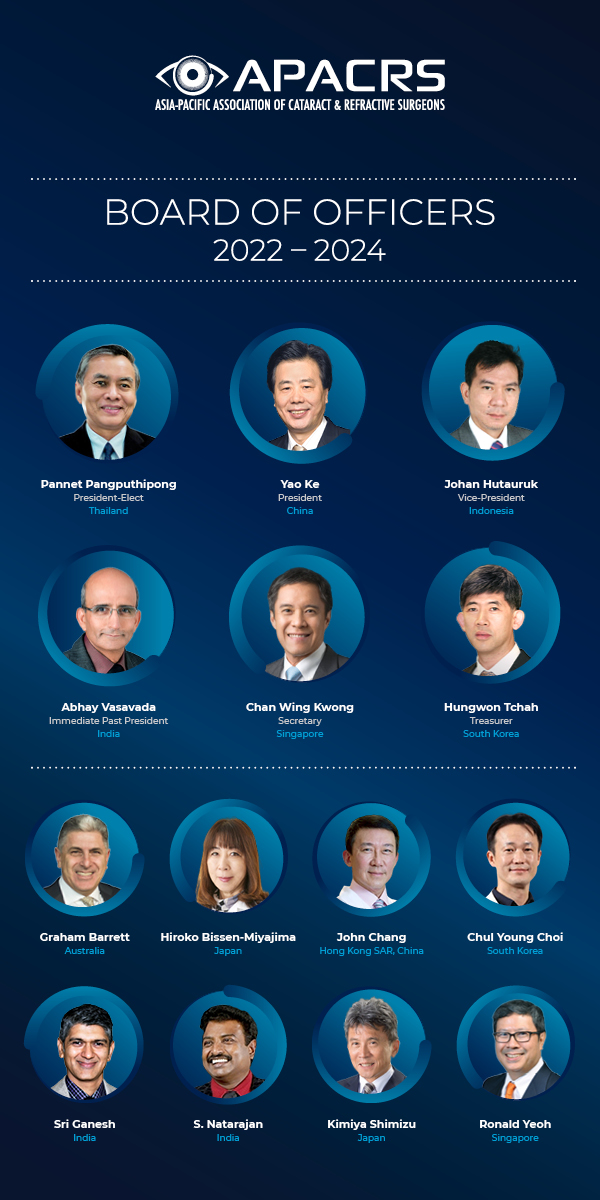
 EyeSustain Update
EyeSustain Update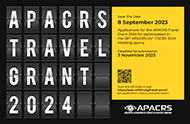 2024 APACRS TRAVEL GRANT
2024 APACRS TRAVEL GRANT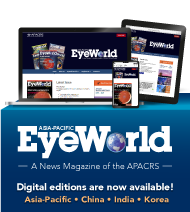 Digital EyeWorld
Digital EyeWorld VOL. 39 (2023), ISSUE 3
VOL. 39 (2023), ISSUE 3  Membership Information
Membership Information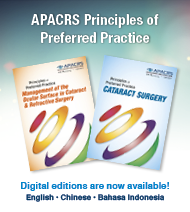 APACRS Principles of Preferred Practice
APACRS Principles of Preferred Practice